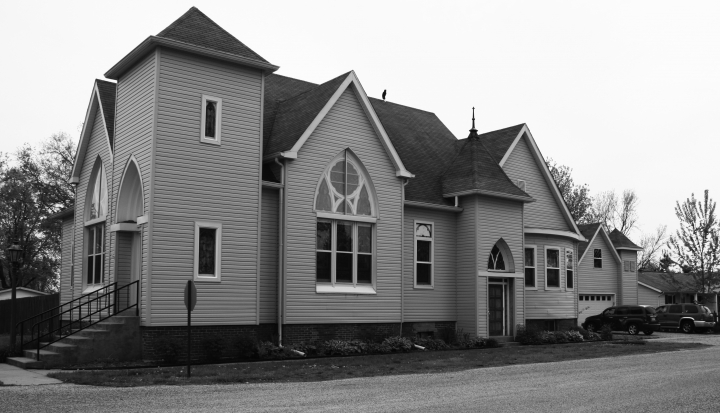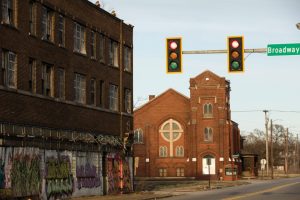Walk down a city street in New York City or take a short drive through Chicago and you are likely to see numerous churches. Take a closer look at one of these buildings, however, and you might be startled to realize you are actually looking at an apartment building or condominium.
Not that long ago I was walking through my parish neighborhood on the South Side of Chicago and I stumbled across a church I hadn’t seen before. As I looked closer I saw that the church had been converted into luxury apartments. As a person of faith, how does one feel looking at such a transformed space? A myriad thoughts and emotions surfaced in me. Initially, it was simply a sense of loss. Here was a house of worship, a place where the Christian community had gathered to offer praise and thanks to God. Here was a place that had housed powerful moments in the life of a community, from baptisms to funerals. Here was the vestige of Christian values and witness turned into an apartment building.
Despite the validity of those thoughts and emotions, it’s important not to romanticize the past, give way to despair, or extrapolate too much from the experience. It is perhaps commonplace for Catholics in the Midwest and Northeast to gaze around their congregations on Sundays and observe a diminishment in attendance. Often this can lead to a lament about the decline of faith, criticism of secular values, or a challenge to parish pastoral staffs to “do more to attract youth and young families.” Yet the picture of how the church in the United States got to this place is much more complex, and the outlook for Catholicism in our country today is much more hopeful.
Historically, the Catholic population in the United States was largely centered in urban areas in the Northeast and the Midwest. It was largely a diverse immigrant population from throughout Europe. For example, in a nine-block radius in that same South Side Chicago neighborhood there were three Catholic parishes that served different cultural groups: Polish, Irish, and Italian. This, of course, as many longtime Catholics remember, was commonplace. Our big city landscapes are peppered by numerous beautiful church buildings built with great dedication, pride, and artistic merit by the congregations who worshiped in those magnificent buildings for years.
However, demographics shift through time. Today, due to a smaller Catholic population in the neighborhood, those three Catholic churches in Chicago have merged into one parish. While there are still strong remnants of the founding Polish, Irish, and Italian communities, the vast majority of the current Catholic congregants are Latino/a and their primary language is Spanish. More than this, the archdiocese, instead of closing these buildings in favor of using just one church building, decided to keep each of the former church buildings open for Sunday liturgies.
While the three parishes merged into one, the worship spaces remained active. However, this has led to great challenges. Each parish has a church, rectory, school building, and convent. All together the new parish entity has 13 old buildings to maintain.
This story is not uncommon. Similarly common are the frustrations of parishioners in these situations who feel that, “all the church cares about is money,” and their primary mission is to maintain these old buildings. It is certainly a great danger to the faith when Catholics who are called by Pope Francis to be “missionary disciples” find themselves instead almost completely occupied with the task of maintaining church buildings, no matter how inspiring the architecture. What to do with sparsely populated church buildings in these changing times is a great challenge to parishes and dioceses, and there are no easy answers.
There’s another side to this story that isn’t discussed enough. As the Center for the Applied Research in the Apostolate (CARA) has reported, since 2014 the Catholic population has been dramatically increasing in the U.S. South and West. In addition to normal family growth, these areas are receiving many families from elsewhere in the United States. Moreover, they continue to receive a significant immigrant population, as has been the tradition of the church in the United States.
CARA reported in 2014 that in 1950, 24 percent of Catholics in the United States lived in the South and West combined. Today, these two regions account for 49 percent of the church’s U.S. population. CARA also observed the dramatic growth of the Catholic population in a place like Atlanta, Georgia. In 1991 the Archdiocese of Atlanta had 176,000 Catholics and 65 parishes. Today, the archdiocese reports over 1 million Catholics and 102 parishes and missions.
As CARA notes, the challenge in these blossoming areas of growth is keeping up with the increasing Catholic population. Not only are there not enough church buildings to house the liturgical life of all of these Catholics, but many of the current church buildings and parish campuses are not even large enough to accommodate the numbers they are receiving.
A brief look through architectural journals such as Faith and Form reveal just how much new innovative construction is occurring in religious architecture. New Catholic churches and chapels are being built informed by the liturgy and theology of the Second Vatican Council. A brilliant example of this is Saint Thomas More Catholic Church in Oceanside, California with its open modern spaces filled with natural light that nevertheless achieve a sense of warmth, belonging, and inspirational grandeur.
Noteworthy too is the recent trend of new churches built using traditional architectural styles. The dioceses of Raleigh, North Carolina and Knoxville, Tennessee have committed to new cathedrals in a traditional Romanesque basilica style, both topped by a dome. Other churches around the country are embarking upon significant renovation projects to restore, enliven, and prepare their church buildings for the future ahead. The average Catholic strolling down the street in the Midwest or Northeast might be impressed to learn not only of these new impressive church buildings and renovations, but also of the large Catholic communities many of these churches are built to accommodate.
All that being said, we are still left with the jarring experience of standing on a street corner and gazing upon an apartment building that used to be a church. Is there anything positive that can be drawn from this experience? Perhaps a comparison can be instructive.
Walk through most art museums in this country and you will discover a medieval Christian art collection. Many of these collections feature vessels like chalices, patens, and monstrances once used for liturgy and prayer. In a museum, removed from their liturgical contexts, they become artifacts and artistic objects to be appreciated but no longer used. They are beautiful, but in a sense, they are dead. They have form but have lost much of their function.
Now consider a church that has been thoughtfully renovated and turned into a home for one or multiple families. The gothic arches, vaulted ceilings, and, in some cases, stained glass windows all continue to speak.
As writers reflecting upon architecture stretching from Henry Adams to Sarah Williams Goldhagen have observed, architectural spaces affect our experience. Christian religious architecture seeks to draw the mind and heart to God. Differing architectural styles have been created to embody different theological perspectives. These buildings continue to speak and form lives.
In fact, it can be argued, the church building itself has become a missionary. If a Christian family makes this space a home, they may more easily make the connection between the eucharistic table of their parish community and the dinner table of their own family, recognizing Christ’s presence in a deeper way. Their daily lives will be formed by the theological ideas built into their walls and windows.
If a family with a more secular perspective inhabits a former church building, then their behaviors, demeanor, and even thoughts will be positively affected by the theological space they inhabit. People act differently in churches. By not tearing them down and making them into homes, the buildings are given a chance to continue to speak and teach and influence a new generation.
These former churches are not museum pieces. Instead, to put a twist on the title of the U.S. bishops’ document on church architecture, they are “Built of Living Stone.” They provide home and shelter, and God is still in their midst. Perhaps then we can look upon some of these buildings with hope and pride. Their mission isn’t finished yet!
Image: Flickr cc via Randy von Liski














Add comment